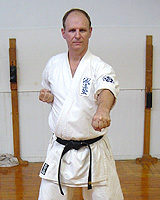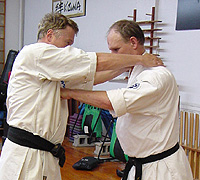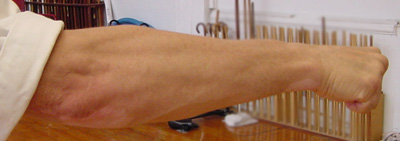A Simple Lesson In Body Mechanics:
Are You Losing Power In Your Punch?
By Christopher Caile
If you practice basic, karate-type punching, you
are probably not aware that you are losing some of
the power of your punches.

I'm not talking about ways to generate more power
into your punch. That's the subject of another article.
I'm also not talking about the basic mechanics of
punching that most people are aware of -- making a
proper fist, keeping the punching arm close to the
body, turning the fist over as it is extended, etc.
What I am talking about is a small but important
element of arm alignment that affects your efficient
transmission of power. Most students and teachers
are not even aware of this. When most people's punches
make contact, some of the power transmitted through
the arm doesn't make it. Instead, all too often the
arm itself acts as a mini shock absorber that bends
when the force between the puncher and target exceeds
a certain level.
A lot of readers are now saying, "not me. I've
spent years developing my punch." You may be
right, but it still may not be working to your full
advantage. Here's is a simple test that I show people.
First, I ask that the person do a basic middle punch
at the level of my solar plexus, as illustrated. Then
with the punch extended, I extend my arms around the
puncher's shoulders and pull the puncher into me.
 When
I do this almost everyone is surprised. As I pull
them forward their elbow bends outward and starts
to collapse. This means that elbow of the arm is positioned
in a way that all the power of a punch may not be
transmitted into the target. Instead, the arm absorbs
some of the power and the person punching may never
know it. When
I do this almost everyone is surprised. As I pull
them forward their elbow bends outward and starts
to collapse. This means that elbow of the arm is positioned
in a way that all the power of a punch may not be
transmitted into the target. Instead, the arm absorbs
some of the power and the person punching may never
know it.
This condition is created by the position of the elbow.

Notice in the first photo that the elbow position
is to the outside of the punching arm, even though
the arm is straight. This is the elbow position that
allows potential power absorption.

In the second photo the elbow is turned, or rotated
slightly downward. It doesn't feel natural at first
and takes quite a lot of practice to perfect it. But,
you can easily test its effectiveness. Try the same
test as above.
First, execute a middle punch the way you usually
do it and then rotate your elbow downward. Another
method to get the correct elbow position for this
test is to execute a vertical punch and then rotate
your fist into a traditional punch position being
careful to keep you elbow in place. After you do this,
then have someone, as the in above example, pull you
in, trying to bend your elbow.
See, it doesn't bend. This way all the power you
generate with hip rotation, body weight, or dropping
your weight can potentially be fully extended into
your target. It can make a big difference.
This is the reason, I believe, that some styles of
karate, such as Isshin Ryu, punch with a vertical
first. The advantage is not so much in the fist position,
but in the elbow, which with a vertical fist naturally
rotates downward.
Besides power, this elbow position also has a secondary
advantage. It protects your elbow from an attack from
the side, a smash against the elbow or trap that would
normally be used to straighten and then injure the
elbow. With the elbow down, it is just not there to
be attacked.
About The Author:
Christopher Caile is the Founder and Editor-In-Chief
of FightingArts.com. He has been a student of the
martial arts for over 40 years and holds a 6th degree
black belt in Seido Karate and has experience in
judo, aikido, daito-ryu, boxing and several Chinese
fighting arts. He is also a long-term student of
one branch of Traditional Chinese Medicine, Qigong.
He is a personal disciple of the qi gong master
and teacher of acupuncture Dr. Zaiwan Shen (M.D.,
Ph.D.) and is Vice-President of the DS International
Chi Medicine Association. In Buffalo, NY, he founded
the Qi gong Healing Institute and The Qi Medicine
Association at the State University of New York
at Buffalo. He has also written on Qi gong and other
health topics in a national magazine, the Holistic
Health Journal and had been filmed for a prospective
PBS presentation on Alternative Medicine. Recently
he contributed a chapter on the subject to an award
winning book on alternative medicine, "Resources
Guide To Alternative Health" produced by Health
Inform.

back
to top
home
| about
us | magazine
| learning
| connections
| estore
|